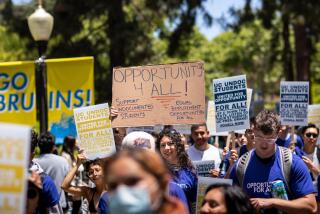Diocese to Give Aliens Aid With Amnesty Law
The Roman Catholic Diocese of San Diego, expected to play a pivotal local role in implementing the new immigration law, will launch a campaign next month to help thousands of illegal aliens secure amnesty, church officials said Tuesday.
Many details are unclear but church officials said they decided to announce the effort because of fears that unscrupulous immigration attorneys and consultants have begun overcharging anxious illegal aliens for minimal services.
“I am sure that certain people will try to take advantage of this situation for their own . . . gain,” Bishop Leo T. Maher said in a statement. “As a diocese, we will seek to do all that is possible to ensure faithful compliance with this new law.”
In fact, however, the San Diego diocese lags behind Los Angeles and Orange County, where church authorities have begun educational efforts and started registering illegal aliens who think they may qualify for amnesty. Earlier this month, the Los Angeles Archdiocese established 20 centers to help an estimated 250,000 illegal aliens seek amnesty under the new law.
There are no centers in San Diego, but diocesan officials downplayed the late start. They noted that the Immigration and Naturalization Service will not accept amnesty applications until May, and that many points about the complex new law remain unclarified. In coming months, the INS plans to issue detailed regulations based on the new law, signed into law by President Reagan Nov. 6.
“The Diocese of San Diego will have relatively the same type of program that Los Angeles and Orange County have,” said Rev. Douglas Regin, the diocese official who is overseeing the San Diego initiative. “At this point, we’re just advising them (aliens) to wait until the regulations come out.”
Illegal aliens are also being advised to begin saving documentation that could prove their residence in the United States, although it is still unclear precisely what kind of documents they will have to produce to demonstrate their residency. In addition, immigrant advocates are waiting to see what special provisions--if any--will be implemented to avoid the breakup of families in which some members will qualify for amnesty and others will not.
Estimates of the number of illegal aliens in San Diego County range from 25,000 to 100,000, most of them citizens of Mexico, church officials said. In Imperial County, which is also covered by the San Diego diocese, the estimates run from 10,000 to 45,000.
The new immigration law would grant temporary residence status to illegal aliens who have lived in the United States continuously since Jan. 1, 1982, or who have worked at least 90 days in agriculture during a recent 12-month period. After receiving temporary visas, successful applicants would be eligible to apply for permanent resident status, and, eventually, for full citizenship.
Another much-awaited INS decision centers on how liberally the agency will interpret language in the law stating that “brief” and “casual” absences from the United States between 1982 and 1986 will not disqualify amnesty candidates. Because of San Diego’s proximity to the U.S.-Mexico border, many illegal aliens here frequently return to Mexico--a habit that could jeopardize even long-time residents’ chances for amnesty, depending on the INS’s position.
Beginning in May, illegal aliens who think they may qualify for amnesty will have one year to submit their applications. However, aliens currently in deportation proceedings will have only 30 days to apply.
The amnesty provisions of the new immigration bill assign a key role to reputable, community-based agencies, such as those run by the Catholic Church. Such nonprofit groups are expected to do much of the initial screening of amnesty applicants, thereby sparing aliens the often-intimidating obligation of having to visit INS offices first.
The San Diego diocese’s amnesty program has developed comparatively slowly, Rev. Regin said, because the diocese here has had no program that concentrated on Latino immigrants. Catholic officials in Los Angeles and Orange County have run Latino-oriented programs, he noted, while the San Diego diocese worked through an independent agency or concentrated on refugees from Southeast Asia, Afghanistan and elsewhere.
“As a result, it’s taking us a little longer,” said Rev. Regin, who is executive director for Catholic Community Services for the San Diego diocese.
In coming weeks, Rev. Regin said, the San Diego diocese plans to set up counseling centers throughout San Diego and Imperial counties, concentrating on heavily Latino parishes. The diocese plans to spread the word about its efforts through churches, word-of-mouth and via advertising in the Spanish-language media, he said. A registration program for aliens is scheduled to begin Feb. 1. Minimal fees will be charged according to need.
To staff the effort, Rev. Regin added, the diocese plans to hire 10 new counselors and employ as many as 100 volunteers. Because government reimbursement is expected to be minimal, he said that donations and fund-raisers would be necessary to defray the estimated $300,000 cost of the program. The initiative is scheduled to last about three years, encompassing the current informational stage, the one-year application period and the subsequent 18-month period during which some aliens may file for permanent resident status.
More to Read
Sign up for Essential California
The most important California stories and recommendations in your inbox every morning.
You may occasionally receive promotional content from the Los Angeles Times.










